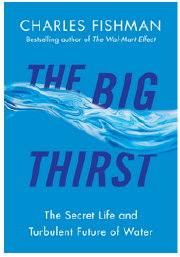Charles Fishman on the ‘Silent Revolution’ in Water Use
There has been “nothing less than a revolution in water use” in the U.S. writes Charles Fishman in the new “The Big Thirst: The Secret Life and Turbulent Future of Water,” with companies now tracking their water use, reporting it publically, and reimagining it.
“Despite living lives that are literally awash in water, Americans in 2005 used less water per person than they did in 1955. It has been nothing less than a revolution in water use in the biggest economy in the world, a completely silent revolution.”
So writes investigative reporter Charles Fishman in the opening chapter of his new book “The Big Thirst: The Secret Life and Turbulent Future of Water” (Free Press), which was published this week.

In an interview this week on the radio program Fresh Air, Fishman laid out some of the good news / bad news sides of the issue. He detailed IBM’s story, one of the good news pieces, and how the company “kind of stumbled into real water innovation.” IBM makes microchips at its Burlington, Vermont, factory, using “ultra pure water” to wash the chips between manufacturing steps. The company went looking for ways to reduce its useage, Fishman said, and identified some places where it was wasting highly pure water and other places where it was heating cool water and cooling hot water and could, instead, use the water just as it was in different places in the factory and save on electricity. “Over 10 years, [IMB] reduced their water use by a third while they increased their chip production by a third,” Fishman said. “They increased the efficiency of their water productivity by about 80 percent.”
Municipalities, of course, are in the game, too. Fishman talked about how Las Vegas, which is dealing with one of the biggest water shortages in the country, now pays residents $40,000 an acre to take out their lawns and replace them with rocks and native plants. Its golf courses have switched large swaths of land from grass to turf, cutting water bills in half in the process.





Comment (1)
Sivaramakrishnan